Twin Screw Pump
What is a twin screw pump?
A twin screw pump is a type of rotary positive displacement pump. Twin screw pump is also known as two screw pump or double screw pump. The name is so because the pumps have two screws. In a twin screw pump, the media being pumped enters the pump via the inlet valve. It then flows linearly to the outlet end of the pump along with interlocking screws. A small gap between screws and the cavity increases pressure in the fluid as the fluid flows via the pump. Twin screw pump is one of the most versatile pumps commonly used in heavy duty applications such as chemical processing, power generation, refineries, oil and gas production, pipeline among others. This type of screw pump is known for its few rotating parts and thus low maintenance requirements. Twin screw pumps help to effectively deliver a fixed volume of fluid in a variety of volume ranges, pressure, and viscosity. These pumps are self-priming. Twin screw pumps are powered by a prime mover which is either an electric motor or IC engine.
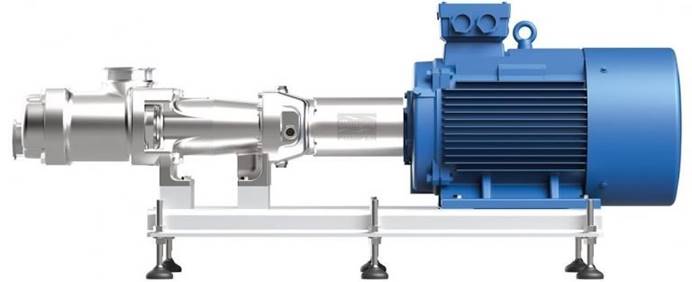
Figure: Twin screw pump.
How does a twin screw pump work?
The twin screw pump is made up of two parallel screws. The screws are of helical shape. Each screw forms a helical channel which becomes periodically obstructed by the second screw. Using this arrangement establishes small locks or chambers full of multiphase mixture. As the screws rotate, the chambers keep moving continuously along the screw axes transferring fluid from the inlet side to the outlet side. The flow rate of a twin screw pump is determined by the volume of the chambers as well as the pitch and size of the screws and the pump rpm. The pump gets power from a prime mover which is either an induction electric motor or IC engine. The power from the prime mover is transmitted to the pump using the shaft element. This shaft is known as the driver shaft and it is connected to the drive screw. The other shaft is driven via a timing gear. This gear transmits power to the second screw. Twin screw pumps rotate at rpm between 1500 rpm and 2400 rpm.
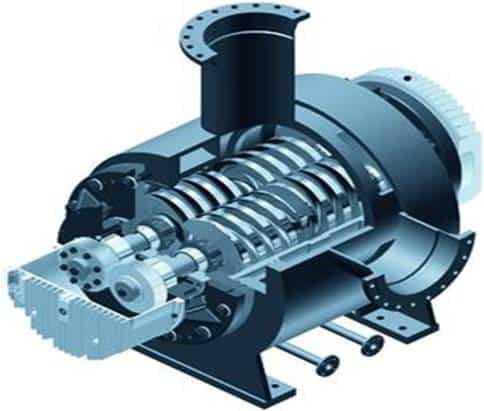
Figure: Working of a twin screw pump.
Components of twin screw pump
Twin screw pump consists of several parts among them the driver screw, driven screw, drive shaft, suction and discharge port, bearings, rotary and stationary seal, relief valve, and timing gear.
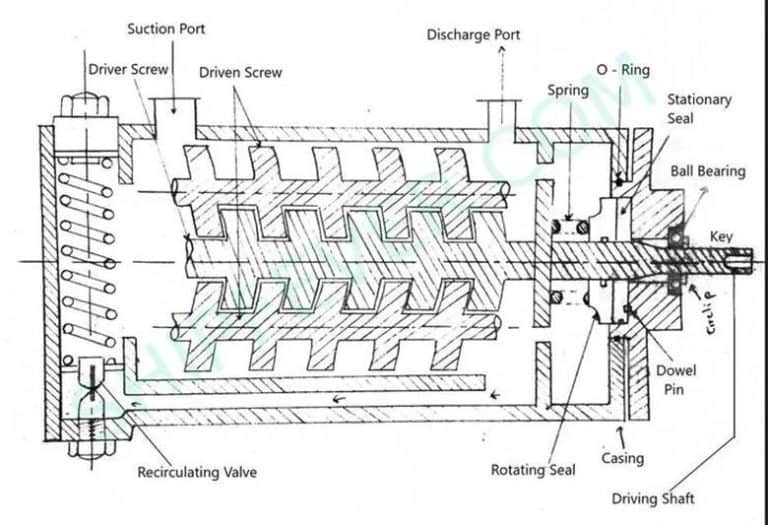
Figure: Components of twin screw pump.
Driver screw
This is the part of a twin screw pump used to help the pump transfer consistent flow at any instant of rotation. This screw rotates together with the driven screw with close clearance to transfer the fluid forward along the axis of rotation. This screw is a spindle with screws machined on it and made of a strong material such as high tensile steel. The driver screw is tasked to rotate the driven screw by the use of a timing gear. As the driver screw gently moves along the low clearance together with the driven screw to help produce low shear effect. This also helps to enhance the life of the pump as it avoids conditions such as fluid medium emulsification in case of contaminated water or impacting negatively on the other machinery connected to the pump.
Driven screw
The driven screw is made of the same strong material as the driver screw such as high tensile steel. This screw gets power from the timing gear. The driven screw in a twin screw pump rotates in opposite direction to the driver screw. The driven screw has consistent clearance which helps to catch fluid into the tight clearance. As the driven and driver screws rotate together, fluid volume decreases and it moves to the outlet port. The fluid pressure increases due to this movement. Finally, the fluid exits the pump via the outlet port.
Timing gear
As both the driver and driven screw run with fine clearance they could by chance make contact. A single contact can easily wear the screw edge thus drastically reducing output pressure. If it is not checked, it can easily make the twin screw pump far less efficient and uneconomical as well as make the screws lock each other. As such, a timing gear is used to check such cases. The timing gear is used to drive the driven screw such that there is no metal-to-metal contact between the driver screw and the driven screw. Also, this gear ensures zero metal-to-metal contact of the screws in case the pump runs dry for a certain period.
Suction and discharge port
Twin screw pumps have various inlet and outlet ports as the fluid being pumped moves along the screw axis of rotation to the discharge port. The inlet and outlet ports are made in a way that helps them to hold enough fluid when the pump turns off. This provides initial fluid into the pump and thus it prevents the pump from running dry for a short period even when the suction pipe is dry or empty. The inlet port gets partial vacuum when there is a pressure difference between the pump inlet and discharge port. This creates the energy needed to transfer the fluid into various confined areas in the screw clearance. As the inlet port experiences partial vacuum, the outlet port experiences high pressure where the pump tries to push more fluid.
Pressure relief valve
The twin screw pump can build up pressure while its outlet is closed. This pressure can result in damage to the internal parts of the pump or even cause injury to the pump operator. As such, twin screw pump manufacturers design the pump with a relief valve. This valve helps to protect the operator and pump and other connected machinery. The use of this valve is to send back excess pressure to the inlet section.
Bearings
In a twin screw pump that is vertically mounted the bearings that experience higher loads are those on the upper side. These bearings experience radial and axial forces when the pump is working. This makes the bearings on the lower side experience very low loads. The lower bearings are meant for sustaining the alignment of parts in the pump. For twin screw pumps installed in parallel, the sliding and roller bearings used experience very low loads. This happens because the axial and radial forces on the bearings are in opposite directions thus canceling out their magnitudes.
Driving shaft
The driving shaft on the twin screw pump is used to connect the motor shaft to the other parts of the pump. The connection is attained by the use of a flexible coupling. In twin screw pumps, the driving shaft is sometimes used as a key part that runs from each side to secure the rotation of the drive screw. In such designs, the driving shaft uses bearings fitting in the axial direction. This makes the alignment of the driving shaft very important as its slight misalignment can make the pump malfunction.
Stationary and rotary seal
Twin screw pump manufacturers design the pumps with mechanical seals to seal the surface between the working fluid and the dry side of the pump. This helps to keep the timing gear and the bearings separated on one side of the twin screw pump as the shaft coupling and the bearings separate on the other side. Other twin screw pumps have extra gland packing mounted after the mechanical seal to enhance leakage-free seal at the suction. It is recommended that if a mechanical seal leaks 6 to 8 drops in one hour be replaced immediately with a new one. This is because as it remains unchecked the leakage grows quicker and quicker and it may damage the pump.
Types of twin screw pump
Types of twin screws are defined on several factors such as functions, orientation, operating conditions among others. This makes the twin screw pump have several models of pumps as described below.
Horizontal twin screw pump
These are twin screw pumps used where the fluid to be pumped is clean and of lubricating properties. This type of pump is made of internal bearings which are lubricated by the fluid being pumped. As the name “horizontal” suggests, these pumps have their suction and discharge ports oriented horizontally. These pumps can be used in wide applications such as dairy farming, food, and beverages, cosmetics among others.
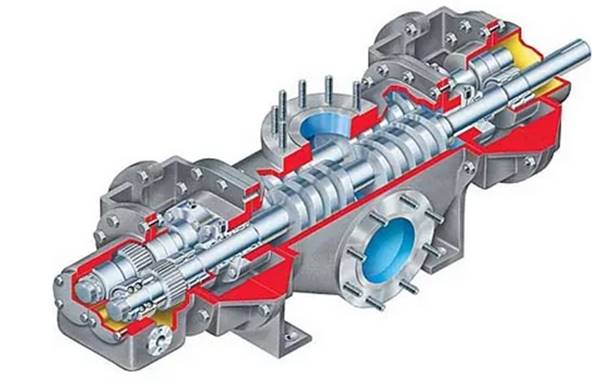
Figure: Horizontal twin screw pump.
Vertical twin screw pump
Vertical twin screw pumps are mostly needed where there is limited space. These pumps have both internal and external bearings. These pumps are designed to enable them work at very high temperatures of 350 oC without or with steam jackets. Such pumps can be used in many applications such as pumping sewage in municipal sewage treatment plant.

Figure: Vertical twin screw pumps.
Hopper twin screw pump
This is a type of twin screw pump with a hopper. The hopper twin screw pump manufacturers design the pump with a customizable hopper. This makes it suitable for the hopper to hold the components to be transported via the pump. This pump is used to transport very viscous media, large solids that need to be shredded, and media with high levels of dry matter.
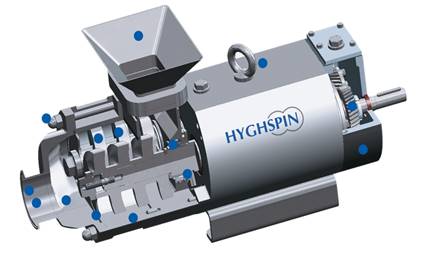
Figure: Hopper twin screw pump.
Advantages of twin screw pump
- Twin screw pumps pump fluids without turbulence. This helps to eradicate bubbles produced when pumping viscous fluids.
- Twin screw pumps can run dry.
- Twin screw pumps have few moving parts which makes maintenance easy and cheaper.
- They have compact structures which makes them strong.
- Twin screw pumps are self-priming.
- Twin screw pumps can highly put up with water vapors and dust particles.
- They pump fluids with low pulsations.
- Twin screw pumps can pump very viscous fluids without loss of flow.
Disadvantages of twin screw pump
- Twin screw pumps need more seals and limited shaft clearance.
- Twin screw shafts tend to deflect under high hydraulic loads.
- They are expensive relative to other pumps such as centrifugal pumps.
Applications of twin screw pump
- Twin screw pumps are used to supply oil to large hydraulic machines.
- They are used in gas and oil production sites.
- They are used in pumping very viscous fluids and fluids with solid particles.
- They are used in chemicals, ceramics, food, paint, and paper industries.
Troubleshooting twin screw pump
Twin screw pump not delivering fluid
- Very high suction lift. Shorten suction pipes or reduce the number of fittings.
- Wrong pump direction of rotation. Change the direction of rotation to be as indicated by an arrow on the pump.
- Air leakage in the pump or suction line. Check and locate where the leakage is and rectify it.
- The suction line is clogged. Remove obstructing materials in the suction line.
- Incorrectly set relief valve. Adjust the relief valve so that it is opening at the pressure level given on the pump manual or nameplate.
Twin screw pump not achieving rated flow
- Speed is very low. Check the speeds for the motor and gearbox on the nameplate and change where necessary.
- Leakage in the pump or suction line. Check the source of leakage and correct it accordingly.
- High losses in the suction line or foot valve. Reduce the number of fittings which increase losses, reduce the length of the suction line.
- Very high discharge pressure. Adjust the discharge pressure to the recommended specifications.
- Fluid is not viscous as required. Bring the viscosity to the required level for example by changing the temperature of the fluid.
- Damaged pump. Check the pump and replace worn or broken components as necessary.
Twin screw pump losses suction a few minutes after starting pumping
- There are vapor pockets or air in the suction line. Rearrange the pipes to eradicate air pockets.
- Air leakage into the pump or suction line. Find the source of air leakage and correct it as necessary. Such sources include valve stem packings, single mechanical seals, and flange gaskets.
Bearings have become very hot
- The pump and motor are not well aligned. Realign the motor and the pump.
- Worn out or damaged bearings. Replace bearings.
- Too high discharge pressure. Lower the discharge pressure to the recommended level.
- Too high speed. Reduce the working speed to the level recommended by the manufacturer.
- Lubrication is not enough. Check and maintain lubrication at a suitable level.
Twin screw pump is very noisy and or vibrating
- Foundation is not rigid. Check the hold-down bolts and tighten them to enhance their torque. Ensure the baseplate is properly grounded without air pockets or voids.
Summary
A twin screw pump is a type of rotary positive displacement pump. This type of pump works by use of the driver and driven screw and timing gear. The twin screw pump gets its power from a prime mover which is an induction electric motor or IC engine. The prime mover power is transmitted to the pump using the driving shaft. The drive shaft transmits power to the driver screw via coupling. As the driver screw rotates it rotates the driven screw via the timing gear. As the screws rotate a partial vacuum is created at the inlet of the pump which forces atmospheric pressure to force the fluid into the pump. The rotation of the screws creates small locks or chambers filled with fluid. The fluid chambers move continuously along the screw axis of rotation as the screws rotate. The fluid moves continuously until it exits through the twin screw pump via the discharge port. A twin screw pump is a versatile pump used in many applications such as oil and gas production, lubrication of hydraulic machines, chemicals, and ceramics, and paper, paint, and food industries.
Twin screw pumps are preferred in many industries for their superb characteristics such as they can run dry, they can work at variable speeds, they are reversible, they need low NPSH, they can work in abrasive fluids and they can handle very viscous fluids. However, twin screw pumps shafts tend to experience deflections due to heavy loads and as well as being expensive to purchase. However, the disadvantages of twin screw pumps cannot outweigh the many advantages.
